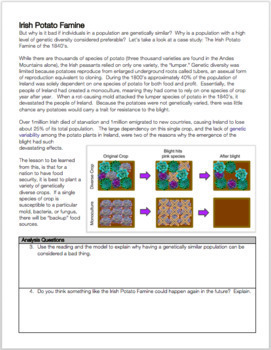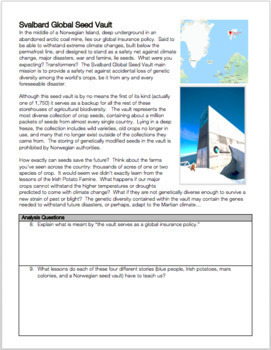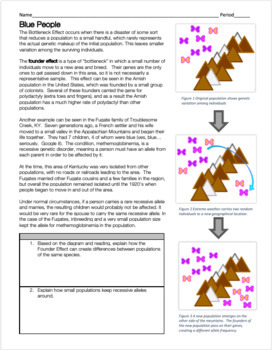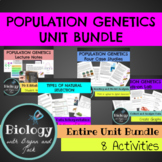Four case studies in population genetics
Biology with Brynn and Jack
954 Followers
Grade Levels
8th - 12th, Homeschool
Subjects
Resource Type
Standards
NGSSHS-LS4-2
NGSSHS-LS4-3
NGSSHS-LS4-4
NGSSHS-LS4-5
Formats Included
- Zip
Pages
8 pages
Biology with Brynn and Jack
954 Followers
What educators are saying
I love being able to use real world scenarios in class. These case studies were great for that. Students had lots to discuss after reading through these.
Also included in
- This bundle contains everything necessary to complete a Population Genetics mini-unit: From bellringers to assessment, this bundle will save you weeks worth of planning. All materials are EDITABLE and come with answer keys when appropriate. All of these materials are available separately at BiologyPrice $14.99Original Price $21.93Save $6.94
- This bundle of 11 EDITABLE, No-Prep assignment is meant to be completed individually and is perfect for an emergency sub plan in any science class. Each page asks students to analyze text and graphs. Print it out, and you're ready to go.Included in this file is a PDF and a Word document so you can fPrice $19.99Original Price $32.89Save $12.90
Description
What do blue people, the Irish Potato Famine, a Mars Colony, and a Norwegian seed vault have in common? Students should be able to tell you by the end of this lesson. This 4 page, EDITABLE, No-Prep assignment can be completed individually, in a small group, or discussed as a class, and is perfect for a low-key day or an emergency sub plan during a population genetics unit. Each page asks students to analyze text and previous knowledge, then respond to analysis questions. Print it out, and you're ready to go.
Included in this file is a PDF and a Word document so you can feel free to use "as is" or modify and differentiate to fit your classroom and students' needs. Enjoy!
Total Pages
8 pages
Answer Key
Included
Teaching Duration
45 minutes
Report this resource to TPT
Reported resources will be reviewed by our team. Report this resource to let us know if this resource violates TPT’s content guidelines.
Standards
to see state-specific standards (only available in the US).
NGSSHS-LS4-2
Construct an explanation based on evidence that the process of evolution primarily results from four factors: (1) the potential for a species to increase in number, (2) the heritable genetic variation of individuals in a species due to mutation and sexual reproduction, (3) competition for limited resources, and (4) the proliferation of those organisms that are better able to survive and reproduce in the environment. Emphasis is on using evidence to explain the influence each of the four factors has on number of organisms, behaviors, morphology, or physiology in terms of ability to compete for limited resources and subsequent survival of individuals and adaptation of species. Examples of evidence could include mathematical models such as simple distribution graphs and proportional reasoning. Assessment does not include other mechanisms of evolution, such as genetic drift, gene flow through migration, and co-evolution.
NGSSHS-LS4-3
Apply concepts of statistics and probability to support explanations that organisms with an advantageous heritable trait tend to increase in proportion to organisms lacking this trait. Emphasis is on analyzing shifts in numerical distribution of traits and using these shifts as evidence to support explanations. Assessment is limited to basic statistical and graphical analysis. Assessment does not include allele frequency calculations.
NGSSHS-LS4-4
Construct an explanation based on evidence for how natural selection leads to adaptation of populations. Emphasis is on using data to provide evidence for how specific biotic and abiotic differences in ecosystems (such as ranges of seasonal temperature, long-term climate change, acidity, light, geographic barriers, or evolution of other organisms) contribute to a change in gene frequency over time, leading to adaptation of populations.
NGSSHS-LS4-5
Evaluate the evidence supporting claims that changes in environmental conditions may result in (1) increases in the number of individuals of some species, (2) the emergence of new species over time, and (3) the extinction of other species. Emphasis is on determining cause and effect relationships for how changes to the environment such as deforestation, fishing, application of fertilizers, drought, flood, and the rate of change of the environment affect distribution or disappearance of traits in species.







